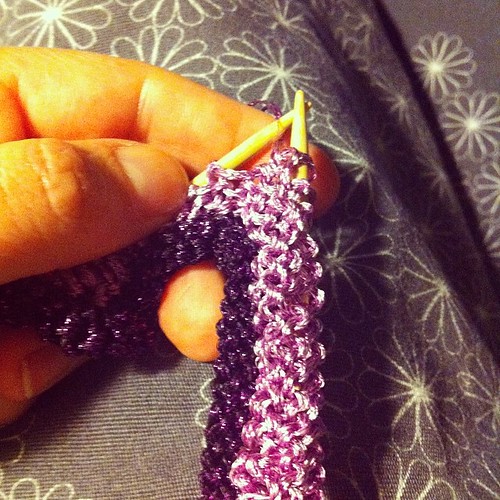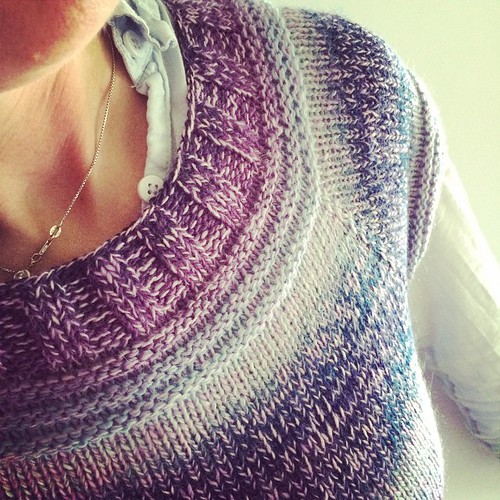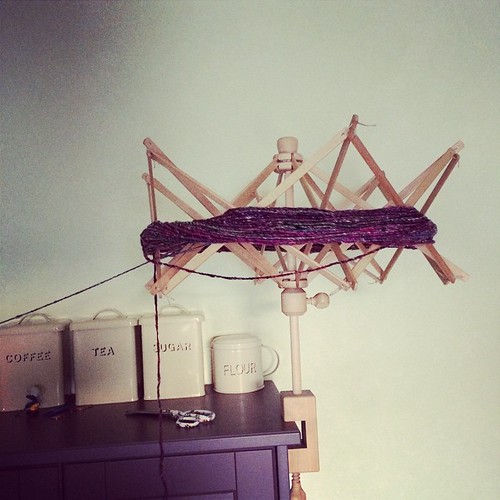Spinning: a passion that has brought you to teach for 30 years. When was this passion born? How did it happen?
I learned to spin more than 36 years ago! I had enjoyed textile crafts, especially knitting since I was a teenager and, like many of my students today, I wanted to be able to create my own yarns. Also at that time there was a lot of interest in 'self-sufficiency' and I had a dream to have my own sheep. That part hasn't happened (yet!) but as soon as I tried spinning I was hooked. Like lots of people I tried to teach myself to spin at first. There was no YouTube in those days but I found a couple of books that were quite helpful. But when I did find a class (in Edinburgh where I worked at that time) I discovered how much better it is to learn with a good teacher who can show you the best techniques, explain why we need to do things a certain way as well as what to do, and who can see what you are doing and guide you to improve. I was lucky to have some good teachers in my early spinning years, including the famous Mabel Ross. As I said, I got hooked straight away and have been very happily addicted to spinning ever since! And I'm still learning.
In your book, "To spin a good yarn...", you've written a sentence I love. "Every new fleece or fibre is an adventure!!"
Can you tell me something about this concept?
As hand-spinners we have the advantage of being able to work with individual fleeces or batches of fibre. The characteristics of the fibre vary not only from breed to breed, but also from individual to individual animal, and from one part of the fleece to another. When we work with the raw material we can really appreciate those individual characteristics and spin yarns to highlight what we like best about the fibre, whether it is texture, lustre or colour variegation. Even if we choose to use some of the vast range of ready-prepared fibres which are available, we can mix textures and colours to create unique and exciting yarns. The possibilities for experimentation are endless.
Spindle or spinning wheel?
I find a spindle is an excellent tool for teaching complete beginners - in my 30 plus years of teaching spinning I have found that nearly everyone gets on better with a spinning wheel if they have first learned with the spindle. The spindle allows us to slow the process right down and separate different phases while we learn what our hands need to do with the fibre. Those manual skills transfer directly to spinning with a wheel when we are ready. Of course a spindle is also a low-cost and very portable piece of equipment and an experienced spinner can spin a wide range of yarns using a spindle. However there are good reasons why spinning wheels were invented - they make the process more efficient so you can spin more yarn in the time available, they make it easier to spin more even yarn (if that is what you want!) and some of the techniques for 'fancy' or 'art' yarns would be difficult if not impossible with a spindle.
I always recommend (and can supply) Ashford spinning wheels, my first wheel was an Ashford Traditional which I still use. Ashford wheels are well made and robust, designed to be easy to use and very versatile. I prefer the single drive (Scotch tension) wheels and find the double-treadle Kiwi and Traveller very comfortable to use. The Kiwi is really good value for money.
In March you are going to teach a class in Florence. Can you tell us something about it?
I'm really excited to be going to Florence in the spring!! As soon as Olena (Holly) asked me if I would be interested I said yes. Of course it is nice to go back to places I've taught in before and see people I now, but going somewhere different and meeting new people is one of the main reasons I do what I do. Actually, teaching in Florence will almost be like coming full circle because the very first spinning class I taught in Italy was in Florence, in a private house almost 5 years ago.
The class in March will be a beginners' course aimed at people with little or no experience of spinning. it will last two days and will give the participants all the skills they need to go home and practice their spinning, with a spindle or a spinning wheel.
On Saturday morning we will start with a raw fleece (I will choose a nice one for the course when I am in Shetland in October for Shetland Wool Week) and I will explain how to choose fleeces, and how to sort the wool into different qualities. Then I will teach carding and combing - two different ways of preparing wool for different types of yarn - and I will explain the differences and when to use each method. I will also explain how to wash fleece but we wont have time to do that and get the wool dry, which is why I will send a fleece from Shetland, which will be clean enough to spin without washing it first.
In the afternoon we will spin the wool we have prepared, using a spindle. I will bring spindles which have been hand-made for me in my home town to my special design, which makes them easy for beginners to use. First we will spin the wool into singles yarn (1-ply - un capo singolo), then we will ply two singles together, and I will explain why plying is important. Finally we will make the yarn into skeins (matasse) and I will explain how to wash and finish it.
On Sunday we will transfer our spinning skills to the spinning wheel. I will explain a bit about different types of wheel and how to maintain them and adjust them for easy spinning. I will need to know how many people will be bringing their own wheels - the number that I can bring will be limited! Again, we will spin singles yarn, and then learn how to ply using the spinning wheels. There will be plenty of time to practice - perhaps a bit more spindle practice as well - and if there is time in the afternoon I will teach a simple way to prepare and spin silk.
I will provide the equipment and materials for use during the class, there will also be the opportunity for people to purchase fibres, equipment and my spinning book. I will be able to organise a bulk shipment before the course so if anyone wants to order a spinning wheel or other equipment I will offer discounted prices and no shipping costs (e-mail me for prices). To take advantage of this offer I need to have orders and payment by 10 February.
What is the thing that you love most about spinning?
There are so many things I love about spinning!! The alchemy of converting greasy wool straight from the sheep into a beautiful finished object - because of course the yarn is not the end product, there is still the knitting or weaving to enjoy! The technical challenge of planning my yarn so that it will be exactly right for the project I have in mind (can I coin the term wool geek?). Discovering the possibilities of untried fibres (I brought fleeces back from Iceland this summer but haven't had time to try them yet). Relaxation and quiet when I'm spinning on my own, and chat and company when I'm spinning with friends, teaching or giving public demonstrations. Probably above all the sheer enjoyment of feeling the fibres pass through my hands and seeing the yarn building up on the bobbin. Then of course there's all the additional pleasure of dyeing (don't get me started...), knitting and (occasionally) weaving. How could I not love it?!




























